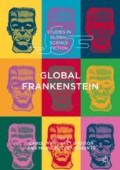Abstract
Comics have an affinity for monsters and a particular affinity for generating monsters that arouse a reader’s empathy. This chapter explores the representational strategies of prose and cinema around Frankenstein’s monster before turning to illustration and comics. Prose excels at presenting subjective experience, while cinema is more attuned to the imprint of the external world. Illustration accompanies printed text with the occasional image, but comics, with more persistent images, uniquely and easily allows the reader continual and intermingled access to both the objective monstrousness of the creature and its less monstrous consciousness. External and internal are kept before the reader’s eyes, giving these representations a complex poignance. Close readings of comics from the 1950s, 1970s and 2000s demonstrate the strategies deployed.
Access this chapter
Tax calculation will be finalised at checkout
Purchases are for personal use only
Notes
- 1.
Thanks to my editor Carol Margaret Davison for linking the bodies of these monsters to those of their readers. By the way, these monster-heroes were directly descended from the more monster-y monsters Marvel was featuring in the late 1950s and early 1960s. By turning its monsters into aliens, Marvel was able to elude the Comics Code Authority; Fin Fang Foom, for example, was an extraterrestrial dragon modestly sporting purple shorts.
- 2.
She adds, ‘Once the monster becomes visible within contemporary horror films, monstrosity becomes less and less recuperable’ (Halberstam 1995: 39).
- 3.
That edition featured but two facing images, on the frontispiece and title page (engraved by W. Chevalier from illustrations by Theodor Von Holst). These are effectively discussed in Ian Haywood, ‘Image of the Month: Theodore Von Holst, ‘Frankenstein’ (1831),’ https://romanticillustrationnetwork.wordpress.com/2016/11/26/image-of-the-month-theodore-von-holst-frankenstein-1831/
- 4.
In conversation, 2017.
- 5.
Incredibly, this unique characteristic of the medium has fallen from fashion over the past few decades in favour of running captions that mimic the more cinematic device of the voice-over.
- 6.
Ploog apprenticed under Will Eisner, whose work similarly revelled in expressive close-ups while remaining appealingly cartoony.
- 7.
This device was also used to introduce the ‘monstrous’ Buddy Love in Jerry Lewis’ The Nutty Professor (1963) a few years later.
- 8.
There is so much more to say about Mignola’s work. See my Hellboy’s World: Comics and Monsters on the Margins (University of California Press, 2016).
- 9.
In her editorial notes to this essay, Carol Margaret Davison comments that Mignola ‘opens up an entirely new avenue with Frankenstein in this instance, one that resonates with the narratives of Dracula and other doomed Gothic immortals.’ I fully agree, and wish I had the space to pursue that crucial development.
Works Cited
Bender, John B., and Michael Marrinan. 2010. The Culture of Diagram. Stanford: Stanford University Press.
Brooks, Mel (director, co-writer). 1974. Young Frankenstein. 20th Century Fox.
Bukatman, Scott. 2016. Hellboy’s World: Comics and Monsters on the Margins. Berkeley: University of California Press.
Denson, Shane. 2011. Marvel Comics’ Frankenstein: A Case Study in the Media of Serial Figures. Amerikastudien/American Studies 55 (4): 531–553.
———. 2014. Postnaturalism: Frankenstein, Film, and the Anthropotechnical Interface. Bielefeld: Transcript-Verlag.
Feldstein, Al, and Jack Davis. 1953. Mirror, Mirror, on the Wall. Tales from the Crypt, 34.
Friedrich, Gary, Mike Ploog, et al. 2015. The Monster of Frankenstein. New York: Marvel Comics.
Gabilliet, Jean-Paul. 2010. Of Comics and Men: A Cultural History of American Comic Books. Trans. Bart Beaty and Nick Nguyen. Jackson: University Press of Mississippi.
Gunning, Tom. 1999. Narrative Discourse and the Narrator System. In Film Theory and Criticism: Introductory Readings, ed. Leo Braudy and Marshall Cohen, 470–481. New York/London: Oxford University Press.
Halberstam, Judith. 1995. Skin Shows: Gothic Horror and the Technology of Monsters. Durham/London: Duke University Press.
Haywood, Ian. 2016. Image of the Month: Theodore von Holst, ‘Frankenstein’ (1831). https://romanticillustrationnetwork.wordpress.com/2016/11/26/image-of-the-month-theodore-von-holst-frankenstein-1831/
Mendelsund, Peter. 2014. What We See When We Read: A Phenomenology With Illustrations. New York: Vintage Books.
Metz, Christian. 1974. On the Impression of Reality in the Cinema. In Film Language: A Semiotics of the Cinema. New York: Oxford University Press.
Mignola, Mike, and Ben Stenbeck. 2015. Frankenstein Underground. Portland: Dark Horse Comics.
Morrison, Grant, and Chris Weston. 2004. The Filth, Issue 10. Vertigo Comics: New York.
Nadel, Dan. 2006. Art Out of Time: Unknown Comics Visionaries 1900–1969. New York: Harry N. Abrams.
Nestrick, William. 1979. Coming to Life: Frankenstein and the Nature of Film Narrative. In The Endurance of Frankenstein: Essays on Mary Shelley’s Novel, ed. George Levine and U.C. Knoepflmacher. Berkeley/Los Angeles/London: University of California Press.
Peake, Richard Brinsley. 1823. Presumption: Or, the Fate of Frankenstein. http://www.rc.umd.edu/editions/peake/index.html
Raub, Emma. 2012. Frankenstein and the Mute Figure of Melodrama. Modern Drama 55 (4): 437–458.
Redfield, Marc. 2003. Frankenstein’s Cinematic Dream. Romantic Circles. https://www.rc.umd.edu/praxis/frankenstein/redfield/redfield.html
Scott, Grant F. 2012. Victor’s Secret: Queer Gothic in Lynd Ward’s Illustrations to Frankenstein (1934). Word & Image 28 (2): 206–232.
Shelley, Mary. 2016. Frankenstein: The Lynd Ward Illustrated Edition. New York: Dover.
Shelley, Mary, and Barry Moser. (1983). Frankenstein, or, The Modern Prometheus, The Pennyroyal edition. West Hatfield: Pennyroyal Press.
Weiss, Allen S. 2004. Ten Theses on Monsters and Monstrosity. TDR: The Drama Review 48 (1): 124–125.
Whale, James (director). 1931. Frankenstein. Universal Pictures.
Author information
Authors and Affiliations
Editor information
Editors and Affiliations
Rights and permissions
Copyright information
© 2018 The Author(s)
About this chapter
Cite this chapter
Bukatman, S. (2018). Frankenstein and the Peculiar Power of the Comics. In: Davison, C., Mulvey-Roberts, M. (eds) Global Frankenstein. Studies in Global Science Fiction. Palgrave Macmillan, Cham. https://doi.org/10.1007/978-3-319-78142-6_11
Download citation
DOI: https://doi.org/10.1007/978-3-319-78142-6_11
Published:
Publisher Name: Palgrave Macmillan, Cham
Print ISBN: 978-3-319-78141-9
Online ISBN: 978-3-319-78142-6
eBook Packages: Literature, Cultural and Media StudiesLiterature, Cultural and Media Studies (R0)

